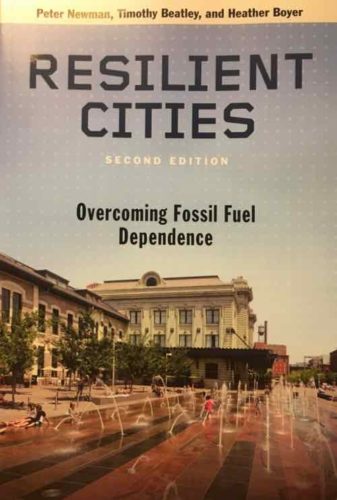Reading: Resilient Cities, 2nd Edition: Overcoming Fossil Fuel Dependence
 One could argue that St. Louis is resilient to have survived major population and job loss, in the center of a stagnant region. The cities presented in a new book. Resilient Cities, are very different places:
One could argue that St. Louis is resilient to have survived major population and job loss, in the center of a stagnant region. The cities presented in a new book. Resilient Cities, are very different places:
What does it mean to be a resilient city in the age of a changing climate and growing inequity? As urban populations grow, how do we create efficient transportation systems, access to healthy green space, and lower-carbon buildings for all citizens?
Peter Newman, Timothy Beatley, and Heather Boyer respond to these questions in the revised and updated edition of Resilient Cities. Since the first edition was published in 2009, interest in resilience has surged, in part due to increasingly frequent and deadly natural disasters, and in part due to the contribution of our cities to climate change. The number of new initiatives and approaches from citizens and all levels of government show the promise as well as the challenges of creating cities that are truly resilient.
The authors’ hopeful approach to creating cities that are not only resilient, but striving to become regenerative, is now organized around their characteristics of a resilient city. A resilient city is one that uses renewable and distributed energy; has an efficient and regenerative metabolism; offers inclusive and healthy places; fosters biophilic and naturally adaptive systems; is invested in disaster preparedness; and is designed around efficient urban fabrics that allow for sustainable mobility.
Resilient Cities, Second Edition reveals how the resilient city characteristics have been achieved in communities around the globe. The authors offer stories, insights, and inspiration for urban planners, policymakers, and professionals interested in creating more sustainable, equitable, and, eventually, regenerative cities. Most importantly, the book is about overcoming fear and generating hope in our cities. Cities will need to claim a different future that helps us regenerate the whole planet–this is the challenge of resilient cities. (Island Press)
The contents show you the organization:
- Introduction. Urban Resilience: Cities of Fear and Hope
- Chapter 1. Invest in Renewable and Distributed Energy
- Chapter 2. Create Sustainable Mobility Systems
- Chapter 3. Foster Inclusive and Healthy Cities
- Chapter 4. Shape Disaster Recovery for the Future
- Chapter 5. Build Biophilic Urbanism in the City and its Bioregion
- Chapter 6. Produce a More Cyclical and Regenerative Metabolism
- Conclusion. Growing Regeneratively
Great subjects.
— Steve Patterson